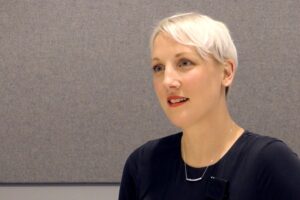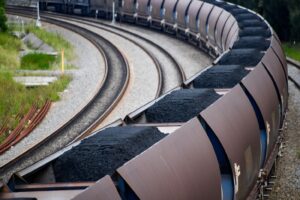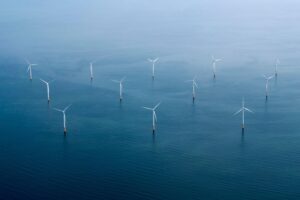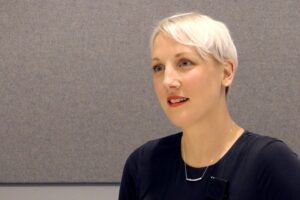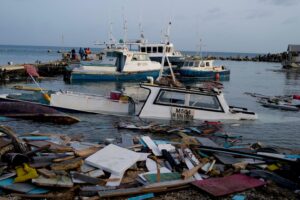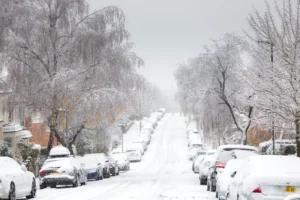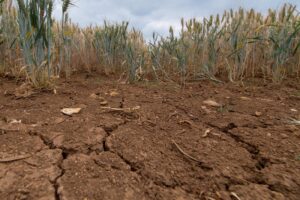Liquor is just one of the markets needed for the cover crop and cereal grain to improve the health, water retention and carbon sequestration of soils, and keep them from blowing away.
Farming in the San Luis Valley, Colorado, is tough. The 8,000-square-mile, high-altitude desert has one of the shortest growing seasons in the United States. It is known for strong winds, and in the increasingly common dust storms that plague the region, local farmer Sarah Jones has been unable to pick her children up from school. Two years ago, wind-driven dust so obscured drivers’ vision that it led to a 15-car pile-up on the highway.
America’s Rye Whiskey Resurgence Could Help the Climate, but Not by Itself
Climate Change
Revealed: Only a third of national climate pledges support ‘transition away from fossil fuels’
Only around a third of the latest country climate pledges submitted to the UN express support for the “transition away from fossil fuels”, according to Carbon Brief analysis.
Several countries even have used their 2035 climate plans to commit to increasing the production or use of fossil fuels, predominately gas, the analysis finds.
The first global stocktake of progress to tackle climate change, agreed at the COP28 climate summit in Dubai in 2023, calls on all countries to contribute to “transitioning away from fossil fuels”.
Countries were meant to explain how they are implementing the outcomes of the global stocktake, including their contribution to transitioning away from fossil fuels, in their latest climate plans.
However, just 23 of the 63 plans submitted to the UN so far express support for “transitioning away from fossil fuels”, or the “phase out” or “phase down” of their use.
In addition, six countries, including Russia, Nigeria and Morocco, use their climate plans to commit to boosting gas production.
Some two-thirds of countries have not yet announced or submitted their pledges, missing not only the UN deadline of 10 February, but also an extension to September.
How to address the lack of sufficient action from countries with their latest plans is billed to be one of the major issues up for debate at the COP30 climate summit in Brazil next month.
Taking stock
In 2015, countries forged the Paris Agreement, the landmark deal to keep temperature rise “well-below” 2C, with “aspirations” to limit global warming to 1.5C of warming by the end of this century.
At the time, countries’ initial pledges were not enough to put the world on track to meet the temperature targets, so they built a “ratchet mechanism” into the Paris Agreement, requiring them to keep increasing their ambition in the following years.
As part of this, countries agreed to submit new, more ambitious plans every five years detailing what they are doing to take action on climate change and adapt to its impacts. These are called “nationally determined contributions” (NDCs).
The Paris Agreement also stated that, following on from these plans, “global stocktakes” should be conducted to assess collective progress in meeting the temperature goal.
The first global stocktake concluded at the COP28 climate summit in Dubai in 2023, with countries agreeing to a new document setting out how they will respond to a lack of sufficient action to meet the Paris goals.
The two-week talks saw fierce debate about how fossil fuels – the main driver of human-caused climate change – should be referred to in this text.
In the end, the stocktake “calls on” all countries to “contribute to” a list of global goals, including “transitioning away from fossil fuels…accelerating action in this critical decade” towards net-zero by 2050.
It was the first time that countries formally acknowledged the need to transition away from fossil fuels in almost 30 years of international climate negotiations.
However, many countries were disappointed that the text did not contain a firmer commitment to phase out all fossil fuels, or even just those with “unabated” emissions.
After Dubai, countries were expected to come up with new NDCs for 2035 that explained how they responded to the priorities set out in the stocktake.
The deadline for submitting the “3.0” NDCs was 10 February 2025, which 95% of countries missed.
On 24 September, the UN convened a climate summit in New York at the sidelines of the UN general assembly in the hope of encouraging more countries to come forward with new NDCs.
China stole the show at the event, announcing a pledge – although not yet formally submitted to the UN – to cut greenhouse gas emissions to 7-10% below peak levels by 2035. Several other countries announced new plans, including Russia, Turkey and Bangladesh.
Following the summit, around one-third of countries have announced or submitted their 2035 NDCs.
Fossil-fuel focus
For the analysis, Carbon Brief reviewed each of the NDCs submitted to the UN to determine whether they express support for “transitioning away” from fossil fuels or for phasing them out or “down”.
Countries were considered to have expressed support if they explicitly mentioned the terms “transition” or “phase out/down” in relation to “fossil fuels” when speaking about their own actions to address climate change.
Some countries spoke in general terms about “reducing” or “replacing” fossil fuels, but did not explicitly reference the need to transition away from or phase them down or out. Others spoke about transitioning to a clean or renewable-based economy, but did not explicitly mention fossil fuels.
For the purposes of this analysis, all of these countries were considered to have not expressed support for the need to transition away from fossil fuels.
In addition, some countries mentioned in their NDCs that the global stocktake calls for a transition away from fossil fuels, but did not say that transitioning away from fossil fuels would be part of their own actions to address climate change.
These countries were also considered to have not expressed support for the need to transition away from fossil fuels.
Overall, the results show that only one-third of countries express support for the need to transition away from fossil fuels in their NDCs.
Countries used varying language when speaking about the need to transition away from fossil fuels.
Some directly acknowledged that transitioning away from fossil fuels was a key conclusion of the global stocktake and committed to doing this within their own borders.
This includes the UK, Brazil, Canada, Australia, Singapore, Lebanon and Niue. For example, the UK’s NDC states:
“At home and in line with the outcomes of the GST [global stocktake], the UK is committed to transitioning away from fossil fuels to achieve net-zero by 2050.”
Other countries chose to commit to “phasing out” fossil fuels instead of “transitioning away”.
This includes Iceland and Vanuatu. Similarly, Colombia’s NDC says:
“NDC 3.0 reaffirms that the phasing out of fossil fuels is not only a climate imperative, but also an opportunity to strengthen energy sovereignty [and] democratise the benefits of the transition.”
(Colombia and Vanuatu were two of the countries that were disappointed not to see a commitment to phase out fossil fuels included within the global stocktake text.)
Barbados, an island nation known for its strong commitment to climate action, committed in its NDC to “achieve a fossil fuel-free economy” by 2040. In addition, Chile pledged to contribute to the “elimination of fossil fuels”.
In the analysis, these pledges were considered to be support for transitioning away from fossil fuels, despite not using the terms “transition” or “phase out”.
The table below shows the language used by each of the 21 countries that expressed support for transitioning away from fossil fuels, according to the analysis.
| Country | Expression of support for ‘transitioning away from fossil fuels’ in NDC |
|---|---|
| United Kingdom | “At home and in line with the outcomes of the GST, the UK is committed to transitioning away from fossil fuels to achieve net-zero by 2050.” |
| Brazil | “Brazil will respond to the call to contribute to global efforts under paragraph 28 of decision 1/CMA.5, through the policies and national efforts below, including those under the National Climate Plan. In addition, Brazil would welcome the launching of international work for the definition of schedules for transitioning away from fossil fuels in energy systems, in a just, orderly and equitable manner, with developed countries taking the lead, on the basis of the best available science, reflecting equity and the principle of common but differentiated responsibilities and respective capabilities in the light of different national circumstances and in the context of sustainable development and efforts to eradicate poverty, as per paragraph 6 of decision 1/ CMA.5.” |
| Canada | “Canada also remains committed to implementing the mitigation outcomes of the Global Stocktake (GST), agreed at COP28…This includes…transitioning away from fossil fuels in energy systems.” |
| Lebanon | “Guided by the UAE Consensus reached at COP28, which calls on all Parties to transition away from fossil fuels and strengthen support for adaptation, this NDC reflects Lebanon’s commitment to scaling ambition while addressing national vulnerabilities.” |
| Iceland | “Iceland’s NDC takes note of the outcome of the global stocktake, according to Decision 1/CMA.5. Specifically, Iceland’s NDC seeks to represent the need for deep, rapid and sustained reductions in greenhouse gas emissions in line with 1.5°C pathways by contributing to the phase-out of fossil fuels across sectors and the strategic, fair and ambitious implementation of carbon capture, utilisation and storage, according to para. 28.” |
| Barbados | “In 2020, the Government of Barbados set the aspirational goal to achieve a fossil fuel-free economy and to reduce GHG emissions across all sectors to as close to zero as possible by 2030. In light of the significant challenges faced by the country, the aspirational goal is currently expected to be reached around 2040.” |
| Chile | “In 2023, within the framework of the 28th Conference of the Parties to the UNFCCC (COP) in Dubai, the report on the First Global Stocktake, designed within the framework of the Paris Agreement to assess the global response to the climate crisis, was presented…Among its main conclusions, the agreement to move towards the elimination of fossil fuels in energy systems…stands out. All these conclusions are addressed in this NDC, demonstrating Chile’s commitment to climate ambition.” |
| Vanuatu | “Moving beyond our current net-zero status, this NDC recommits Vanuatu to rapidly phasing out fossil fuels, deeply decarbonising and transitioning completely to a circular economy.” |
| Pakistan | “Natural gas and furnace oil are set to decline, with net reductions of 2,147 MW and 430 MW respectively, as per IGCEP 2025-2035, signaling a gradual phase down of fossil fuels in Pakistan’s capacity mix.” |
| Colombia | “NDC 3.0 reaffirms that the phasing out of fossil fuels is not only a climate imperative, but also an opportunity to strengthen energy sovereignty, democratize the benefits of the transition, and consolidate Colombia as a Power of Life.” |
| Niue | Niue understands the need to transition from fossil fuel-based electricity generation to renewable energy to reduce the GHG emissions footprint and ensure energy security.” |
| Singapore | “Singapore is contributing to the first global stocktake’s call to triple global renewable energy capacity and double the global average annual rate of energy efficiency improvements by 2030. We are also supporting efforts to transition away from fossil fuels in energy systems and phase out inefficient fossil fuel subsidies.” |
| Australia | “The global stocktake recognised the global direction of travel in its consensus call to transition away from fossil fuels in energy systems and to phase-down unabated coal-fired power. In Australia, our transition is underway.” |
| United Arab Emirates | “The GST Outcome at COP28, together with the broader UAE Consensus and the work under the Troika, has provided a strong impetus for the UAE NDC 3.0. The outcome of the first GST notably emphasizes the need to transition away from fossil fuels in energy systems in a just, orderly and equitable manner, urging parties to adopt ambitious, economy-wide emission reduction targets.” |
| Japan | “The items listed in decision 1/CMA.5 have been incorporated to the greatest extent possible into the Plan for Global Warming Countermeasures, which is a comprehensive implementation plan for achieving Japan’s NDC.” |
| Bolivia | “The persistent dependence on fossil fuels, both for electricity generation and transportation, not only contributes to national greenhouse gas emissions, but also exposes the country to volatility in international oil and gas prices, highlighting the urgency of a fair, sovereign, and resilient energy transition toward renewable sources.” |
| Nicaragua | “The transition to an energy matrix less dependent on fossil fuels is a fundamental priority of the government.” |
| Marshall Islands | “This NDC also demonstrates our drive, our achievements, and the challenges we face. In particular, we detail our domestic actions to contribute to the collective commitments made following the global stocktake, including the tripling of renewable energy, doubling of energy efficiency and removal of fossil fuel subsidies, all in pursuit of accelerating the transition away from fossil fuels this decade.” |
| Cambodia | “This transition will be implemented in two key phases: 70% renewable energy by 2030, followed by a further increase to 72% by 2035, ensuring a gradual yet decisive shift away from fossil fuel dependency in the power sector.” |
| Bangladesh | “Transitioning away from fossil fuels in energy systems, in a just, orderly and equitable manner [is] central to Bangladesh’s contribution to the global response to climate change. The NDC 3.0 commitments are designed not only to reduce Greenhouse Gas (GHG) emissions but also to accelerate the just energy transition, promote zero- and low-emission technologies, and enhance climate resilience.” |
| Tuvalu | “We are steadfast in our transition to 100% renewable energy.” |
| Sri Lanka | “With abundant solar, wind, and hydropower resources, Sri Lanka has a clear opportunity and expressed ambitious commitments to move towards total electricity generation based on renewable sources, to transition away from fossil fuels toward cleaner, decentralised energy systems.” |
| Nepal | Nepal’s NDC is “informed” by Decision 1/CMA.5 Outcome of the first GST, “such as 1.5C decarbonisation pathway…just transition away from fossil fuels in energy systems.” |
Source: Carbon Brief analysis of UN NDC registry
Separately, the thinktank E3G has examined how countries speak about their policies for reducing fossil fuels in their NDCs.
It found that more than two-thirds of countries include “explicit references to displacing fossil fuels in their electricity mix”.
However, E3G also noted that “specific language on winding down the production of coal, oil, and fossil gas is lacking in almost all NDCs”.
‘Transitional fuel’
Carbon Brief also examined each of the submitted NDCs to see how countries speak about new fossil-fuel production and use within their borders.
Six of the 64 nations – around 10% – used their NDCs to pledge to increase fossil-fuel production or use, predominately gas, claiming this could contribute to their efforts to lower emissions.
In its NDC, the world’s fourth biggest emitter, Russia, says it “emphasises the importance of implementing a just transition to low-emission development models using all available solutions”, including “gas as a transition fuel and technologies for reducing emissions in coal-fired power generation”.
During negotiations on the stocktake text in 2023, Russia had pushed successfully to include a controversial paragraph that says “transitional fuels can play a role in facilitating the energy transition while ensuring energy security”, Climate Home News reported.
The publication noted that, after this text was agreed, Antigua and Barbuda negotiator Diann Black-Layne called it a “dangerous loophole”, adding that gas is also a fossil fuel that “we need to transition away from”.
Several African nations, including Nigeria, Morocco, Mauritius and Zimbabwe, also pledged to boost the production or use of gas as part of their “climate” actions.
Nigeria, Africa’s second biggest emitter, says that the country “relies heavily on the oil and gas industry” and that the sector will be “called upon to further grow while adopting sustainability measures”. It continues:
“Natural gas use will be boosted, serving as a key transition fuel in Nigeria’s move towards increased adoption of renewable energy for meeting its net-zero emissions target.”
The world’s energy watchdog, the International Energy Agency, recently reemphasised that there would be no need for any new fossil-fuel production, if the world cuts emissions in line with limiting global warming to 1.5C.
It comes after the world’s top court this year concluded that new fossil-fuel production, consumption, the granting of exploration licences or the provision of subsidies “may constitute an internationally wrongful act”, leaving the states involved vulnerable to legal action.
COP30 calls
After nearly all nations missed the deadline for submitting NDCs in February, UN climate chief Simon Stiell asked laggard countries to do so by the end of September.
This will allow their plans to be included in a new report synthesising the level of progress contained within the latest NDCs, which is due to be published on 24 October. (Less than a third of nations met Stiell’s request.)
The report will come just before COP30, which will take place from 10-21 November in the rainforest Brazilian city of Belém.
Whether and how to respond to the insufficient progress contained within these NDCs, including whether to call for increased ambition in line with the outcomes of the first global stocktake, are among the key issues up for debate at the summit.
The Brazilian presidency is pushing for a formal COP decision on any “disappoint[ment]” over NDCs falling short, collectively, of what is needed to avoid dangerous global warming.
However, other countries would need to agree to this proposal at the summit.
The post Revealed: Only a third of national climate pledges support ‘transition away from fossil fuels’ appeared first on Carbon Brief.
Revealed: Only a third of national climate pledges support ‘transition away from fossil fuels’
Climate Change
The Carbon Brief Interview: UK Met Office chief executive Penny Endersby
Prof Penny Endersby has been chief executive of the UK Met Office since December 2018.
She took the reins at the UK’s climate and weather service after more than two decades working in the science and technology department of the Ministry of Defence.
Endersby has led the Met Office during a critical period which has seen record-breaking heat in the UK, an intensification of extreme weather around the world and a resurgence in attacks on climate science.
At the same time, advances in artificial intelligence (AI) have started to transform climate modelling and the Met Office has switched on a cloud-based “supercomputer” dedicated to improving weather and climate science.
- On how working on defence is like climate change: “There are more scientific parallels than you would think. Armour modelling is computational fluid dynamics modelling, like weather modelling.”
- On her previous interest in climate change: “I am naturally a sort of geeky, evidence-based person. I actually had kept 10 years of rain gauge records in Wiltshire – just because I was interested – before I ever thought about this job.”
- On how the Met Office informs UK climate-change preparations: “Our core bit is on preparing other people to make the decisions on what to expect. So we do the science of the climate projections that says: ‘Where might we be in 2030, 2050, 2100 under different emission scenarios?’”
- On the aspect of UK climate change that concerns her most: “The one that probably keeps me awake at night is the flash flooding – the surface water flooding from very localised torrential rainfall events, because those are the hardest to model.”
- On the Paris Agreement’s 1.5C temperature limit: “It is theoretically possible we stay within 1.5C, but it’s going to require action that’s never been seen and doesn’t look like it’s coming.”
- On geoengineering: “There’s nothing regulating [it] globally. So other people may do it – whether we advocate [for] it or not. So, we do think it is the right thing to do to understand what the impacts of it could be [so as] to be able to detect it if other people do it.”
- On carbon removal techniques: “The best way to get carbon out of the atmosphere is still a tree…The next easiest thing is direct carbon capture…The other techniques – I think they’re worth investigating, but they’re not going to be available at scale in the times that we need.”
- On budget cuts to the US weather and climate service: “I think the actual impact on funding, so far, has not been as severe as some of the news stories have said – because their role is just as fundamental to the operation of the state as ours is.”
- On the reach of the IPCC’s big assessment reports: “I think, in many ways, our best hope now lies in the global financial system. They’re not very altruistic, but they are very rational and they do use the best evidence… And, if the money sends them into different investments or different insurance strategies – that is still going to be based on the evidence that comes out of the IPCC.”
- On the evolution of climate misinformation: “I think the climate data is now so stark, that anyone who looks at the data at all can see that we’re in unprecedented times. [But] what has happened, to my grief and distress, has been people now attacking the trusted sources of data. And in the UK – that’s us.”
- On how the Met Office deals with misinformation: “We have had to become – per force – experts in countering misinformation and disinformation, and, really, to an extent, quite thought-leading in government and in convening cross-government networks to deal with this.”
- On social media attacks on the Met Office: “The aggression that some of our media-facing people face online [and] the really vile hostility which often quite junior staff are dealing with – that definitely is something where we have to take care of and look after people.”
- On personal attacks on social media: “It can be painful, but you really have to rise above it. And when it’s a woman, there’s always a generous salting of misogyny in there as well.”
- On claims about the inaccuracy of Met Office temperature readings: “Just to be clear, the claims are baseless…Everything we do is to the required standards.”
- On potential applications for AI in climate science: “AI for climate change is relatively new – and the challenge is always, what’s the training data set? Because you don’t have the training data set for climate that hasn’t happened yet.”
- On the Met Office’s work with AI: “Our strategy is to go for the best blend of conventional and AI modelling – but we’re still working out what we think that best blend will be.”
- On the Met Office’s first cloud-based supercomputer: “It needs to be [in the cloud], because the amazing, fantastic, wonderful data that we have – [and] on which all of these products and AI is built – is now so big you can’t move it. We have about half an exabyte of data.”
Carbon Brief: Hi Penny. Thanks for joining us. To start off, I wanted to ask: previous to becoming the chief executive of the Met Office, you worked for the science and technology arm of the Ministry of Defence. How did that role prepare you for your current position – and in what ways is working on climate change like defence?
Penny Endersby: I think the whole of that 25-year career as a scientific civil servant prepared me for my current position. And I started off being a researcher myself in armour and explosives, and then leading scientists in larger and larger chunks. My final role was as head of the cyber information division of the Defence Science and Technology Laboratory (DSTL). I was on the board of DSTL as well.
There are more scientific parallels than you would think. Armour modelling is computational fluid dynamics modelling, like weather modelling. I was responsible for big data and AI. I was responsible for space. So, there was lots of crossover. But the main thing was leading the experts and the people who are passionately committed to making lives better through science. That was the biggest crossover with what I do now.
CB: Why did you want to work for the Met Office?
PE: I have to say being chief executive of the Met Office was completely my dream job. I had actually applied to be chief executive of DSTL, very much on a punt, not long before. I got further than I expected – I got down to the last four, but I wasn’t successful. I had good feedback that went [along the lines of]: “Yeah, try again sometime.”
And then the Met Office [job] came up, and it had just had everything I wanted: a mission that I really cared about, doing something valuable, the scientific content, staying a civil servant and working for the government. [And] not being in London, because I am a great lover of the country. I moved from Wiltshire to Devon to take this job. [It was also] a promotion.
It just was the complete package. I gave getting the job everything.
CB: Why did you start becoming interested in climate change? I don’t know if you remember a particular moment or event?
PE: I was interested in [the] weather [and] the natural world from childhood. So I have always been a naturalist. I am naturally a sort of geeky, evidence-based person. I actually had kept 10 years of rain gauge records in Wiltshire – just because I was interested – before I ever thought about this job.
Although I was concerned about climate change and I knew the basics, I didn’t really study it until I got to this job and then was leading the organisation with the Hadley Centre [the Met Office’s climate research centre] in it, with amazing climate scientists and amazing climate science. So that seven years has been a journey of building my knowledge and my expertise.
CB: The Met Office has a mandate to help people make decisions and stay safe and thrive through its weather services. So could you just tell us a little bit about how the Met Office is equipping citizens for the current and future climate?
PE: You are right, that is our purpose – helping you make better decisions to stay safe and thrive. And it is weather and climate.
So on the “staying safe” side, that goes from everything from severe weather warnings in the shorter term, through to [longer-term] making decisions about what flood defences you are needing in the future. And that’s not [directed at] citizens – that’s [directed at] policymakers.
And on the “thrive” side, as well, it might be as simple as, “am I going to go for a run or hang washing out?” [when it comes to] weather timeframes. On climate timeframes, it is about making sure that we have got built infrastructure that enables us thrive in a changing climate, whether that is houses that don’t overheat or green spaces that cool down our urban centres – all those things.
CB: And in terms of preparing for that infrastructure, could you explain a bit more about how the Met Office actually does that?
PE: So our core bit is on preparing other people to make the decisions on what to expect. So we do the science of the climate projections that says: “Where might we be in 2030, 2050, 2100 under different emission scenarios?” [We ask] what does that look like globally and in the UK? We need to know that for our food security and border security and energy security – and nationally, in detail, in the UK.
And then, it is other people who will take that information and decide what to do with it. So, on the adaptation side, we’re really informing other people’s decisions.
CB: Other people being the government…?
PE: It could be local authorities. We have local authority climate dashboards for local authorities to look at how climate change is going to [impact them]. I did notice that Bermondsey, where we are right now, is right at the peak of the bit of London that is expected to be under water – the floodiest bit of London going forward and the hardest to protect.
And then it could be big national decision-makers. I’ll give you a completely different example. If we’re going to have a renewable energy system in the future, the weather we [are having] today is the worst possible weather for renewable energy. It could be cold as well, but it is dull and still. So, [there is] not much wind, not much solar. How long could that wind drought go on and how long could it persist when it’s also cold and there’s a high heating demand? So, we do the modelling that helps the National Energy System Operator plan for how much capacity they need in different weather scenarios and climate scenarios in the future.
CB: What aspects of current or projected climate change in the UK concern you most?
PE: I think the biggest concern is the flooding. And it’s all the sorts of flooding – [including] the coastal flooding from higher sea level [and] the river flooding from extreme rainfall.
The one that probably keeps me awake at night is the flash flooding – the surface water flooding from very localised torrential rainfall events, because those are the hardest to model. The smaller the scale of a phenomenon, the more difficult it is for us to model well in advance.
And yet we know – and we have seen – we have had a few very near misses in this country with the kind of things that affected Valencia or Germany, or that terrible Texas event – very rapid river rises from torrential downpours.
And it’s not just [about the Met Office] getting the rainfall [warnings] right. Our managing director for this area described [these preparations] as a “team sport”. So, we have to get the rainfall right, the hydrological people, jointly with us, have to get the flooding right, the whole of the response system has to respond to understand what’s going to happen. People have to get out and often in maybe only a couple of hours. Whereas for a great big winter storm, we might be giving seven or eight days notice.
CB: Thinking a bit more globally, a new report from a research group based at [the University of] Exeter suggests that a climate tipping point for warm water corals has already been crossed. What does the prospects of these tipping points mean for the work of climate scientists?
PE: It presents us with lots of new challenges, I think.
If there was one thing that shocked me most, going back to the beginning of my time at the Met Office, it was just how long we have known about the fundamentals of climate science – like, 150 years. I had not realised that our understanding of the greenhouse effect and the rough idea of climate sensitivity went back so far. And we have been really well able to understand and project that, really for my whole lifetime. The good climate modelling goes back to about 1970.
But tipping points changed the whole equation for climate science. And, of course, we’re only just beginning to observe them. So, there, we don’t have the track record of projecting it and checking back against what’s happened in reality. So they’re some of the hottest topics – I dare say you might come on to the AMOC [Atlantic Meridional Overturning Circulation]. But all of those areas are very, very active areas of research and areas where the science is not so settled.
CB: The 1.5C warming threshold of the Paris Agreement is looking more fragile than ever. 2024 was the first year-long breach of the limit. How likely is it, in your opinion, that [the rise in] temperatures are limited to 1.5C? And when do you think that could happen?
PE: Well, it is theoretically possible we stay within 1.5C, but it’s going to require action that’s never been seen and doesn’t look like it’s coming. So, we think the opportunity to stay within that first Paris threshold is vanishingly small now – and, if we continue at the current rate, we have only got a few years to go before we cross it long-term.
And, actually, the Met Office has done quite a bit of work looking at how you identify that threshold without waiting for 10 years of averages to go: “Yes, [the limit] was [breached] 10 years ago.”
So then we are into, well, how far can we limit it? Because obviously it’s not a cliff edge. That’s where we think – and I still think – that’s where the more dangerous impacts of climate change kick in. But between 1.5C and 2C – there’s a huge difference. And at 2C, 3C [and] God forbid 4C, all of those impacts multiply. So, it’s how we stay as close [to 1.5C of warming] as we can.
CB: There are growing calls for solar radiation modification and other forms of geoengineering to be considered to tackle climate change. I wanted to get your take on geoengineering as a climate strategy.
PE: The Met Office doesn’t take any particular stance on geoengineering. I need to make it really clear – because we get lots of conspiracy theories – and we do none. We have some very limited modelling to understand what it might look like and what it might do.
I think I might like to draw a distinction between my personal view and the Met Office here. But the only form of geoengineering that actually solves the problem is taking the carbon back out of the atmosphere. Solar radiation modification – it is a masking technique. It doesn’t stop ocean acidification. And once you start, you’ve got to go on, because if you stop, you can get catastrophic, very rapid, catching up.
So, in as much as we advocate anything, it would always be the mitigation techniques [actions that reduce emissions of greenhouse gases] we already know.
Having said that, there’s nothing regulating [geoengineering] globally. So, other people may do it – whether we advocate it or not. So, we do think it is the right thing to do to understand what the impacts of it could be [so as] to be able to detect it if other people do it and understand what they might be doing. It will be a political decision whether it’s a last resort thing to do.
CB: You mentioned carbon removals just now. Scientists at a recent conference on climate overshoot stressed that the 1.5C goal, if breached, needed to be “met from above” with the help of these technologies that remove emissions from the air. How feasible is that, in your view?
PE: The best way to get carbon out of the atmosphere is still a tree. So, some of these are nature-based solutions. And, then, the next easiest thing is the direct carbon capture – so, catch [the carbon] where it is, don’t try to get it back.
The other techniques – I think they’re worth investigating, but they’re not going to be available at scale in the times that we need. It is an entirely good and valid topic for research, but it shouldn’t be a substitution.
CB: Changing topic a bit. The US government has attacked climate science and is cutting national weather and climate services, including access to satellite data. How is this impacting both weather forecasting and climate research at the Met Office?
PE: So we retain a really close collaboration with NOAA [the US National Oceanic and Atmospheric Administration] who are important partners for us. We continue to have access to all of those US satellites that are gathering data. We exchange that through the World Meteorological Organization’s (WMO’s) data exchange.
And the EUMETSAT is the way we gather European satellite data – and the UK is a part of that, and that is all still exchanged.
I think what we are finding is that any government – irrespective of its political stance – needs the fundamentals of what a national meteorological agency can do. Everybody needs a weather forecast, everybody needs warnings, everybody needs aviation, transport, everybody needs defence.
And, so, there’s certainly been a lot of instability in NOAA, while these things work through. And, obviously there’s a government shutdown at the moment. But I think the actual impact on [NOAA] funding, so far, has not been as severe as some of the news stories have said – because their role is just as fundamental to the operation of the state as ours is.
CB: And, a secondary question to that is, are these events or geopolitics impacting the morale at all at the Met Office? And, as a boss, how do you address that, or try to mitigate that if so?
PE: I think the general Met Office staff are really very interested in their science and the mission and not so politically focused. I spent a lot of time thinking about what are the things that we do that will have value under any government and into the future and how we make sure that we can continue to deliver our great services to the government. And we do that with our executive and board.
What does impact morale is some of the misinformation we’ve seen, where we get people attacking the integrity of our observations or the integrity of our scientists. The aggression that some of our media-facing people face online [and] the really vile hostility which often quite junior staff are dealing with – that definitely is something where we have to take care of and look after people.
CB: In the UK, we’ve seen the Conservatives and Reform describe the UK’s net-zero target as “arbitrary”. And, in the US, we’ve seen the president describe climate change as a “con”. So, I wanted to ask you, do you feel that the Met Office and other influential climate science centres have a responsibility to publicly rebut or respond to these claims?
PE: No, absolutely not. The Met Office is a civil service organisation, so we have a very strong mandate to remain impartial and serve the government of the day. We have a government that is really committed to net-zero and being a green energy superpower and we will do everything we can for that. If a democratically elected government comes with a different mandate, our role is to provide that government with the best science to make the best policy decisions they can. It is not to tell them that their policies are wrong.
CB: I want to talk a bit about the IPCC [Intergovernmental Panel on Climate Change] now and the seventh assessment cycle. The IPCC has appointed five Met Office scientists to its newest cycle. What would you like to see the cycle focus on?
PE So I’m not sure I’m really the best person to answer this. Clearly, they are going to be focused on what happens between and above 1.5C. How do we replace that Paris threshold if it has gone? And therefore, increasingly, the adaptation [topic].
Where I actually get more involved is, as a delegate to the WMO and on the Early Warning for All [initiative]. And obviously, the more extreme climate-driven weather events we see, the more crucial early warning is to protect populations. And that will come out of the projections from the IPCC.
CB: I wondered if you had any thoughts on the IPCC’s big assessment reports. Is this model the best way for it to be effective? Or do you think there’s a better option?
PE: I do firmly believe that good decisions have to be based on good evidence. And the IPCC is as good a gold standard as you could have for benchmark evidence in any field.
So that whole process of collecting all the evidence from across researchers across the globe, factoring in what’s effectively a multi-model ensemble, looking at the error bars coming to consensus – it is too slow, right? Because consensus always lags. What the best guess would be – the consensus was always behind it. But I think it is an important model. I’m reminded of Simon Sharpe’s book Five Times Faster [which states that] it is not just [about] the scientists, it is then all the other, the other responses, as well, that need to respond.
I think, in many ways, our best hope now lies in the global financial system. They’re not very altruistic, but they are very rational and they do use the best evidence. They are actually not remotely interested in the politics, because they will look at where the money sends them. And if the money sends them into different investments or different insurance strategies – that is still going to be based on the evidence that comes out of the IPCC.
CB: After the US pulled its officials from attending the last IPCC meeting in China, how could a reduced US contribution impact the work of the IPCC in the upcoming cycle?
PE: I really can’t speak to that. I don’t know enough about it to give you a sensible answer.
CB: All right, let’s come on to misinformation. You mentioned it already. To start off: how is climate misinformation changing in your view?
PE: I’ve really seen this change in the course of this job. I think I was naive when I took this job. One of the things I said in my pitch for the job was: I believe I will be in post in the period when the person in the street in the UK becomes aware of the impact of climate change.
And I think I was right – we have had the first 40C and extreme wildfire events, extreme floods. People have seen it. But, I thought that that would lead to a rational response of people going: “Oh, gosh, they were right all along – we need to do something about it.”
That didn’t happen. What I have seen, therefore, is it was still more or less possible to go “meh, you’ve got the science wrong and you don’t really understand it” seven years ago.
I think the data is now so stark, that anyone who looks at the data at all can see that we’re in unprecedented times. [But] what has happened, to my grief and distress, has been people now attacking the trusted sources of data. And in the UK – that’s us.
We see increasingly statements about all kinds of rubbish, everything from, “you’re hiding the sensors in aircraft jets exhaust to show fake heating – you’ve gone back and changed the past” [to] “you’re measuring temperatures on the ground instead of properly in the Stevenson screen”. [There are] just a raft of things that take us a lot of time and taxpayers money to rebut.
There’s a name for this law and I’ve forgotten it [Brandolini’s law] – but there’s a law that says that, basically, misinformation can be produced in seconds, but takes days to rebut. And this is very, very true.
And, so, we have had to become – per force – experts in countering misinformation and disinformation and, really, to an extent, quite thought-leading in government and in convening cross-government networks to deal with this.
And although I guess I’m speaking to the converted and I’m offering you some rebuttal. That isn’t the best way; the people who firmly believe these things, they’re not remotely interested in your rebuttal.
The best way to maintain the extraordinary trust the Met Office currently enjoys is actually to be putting out the good stories. Here is the plethora of amazing ways we collect weather observations, from deep ocean buoys to space to marine gliders to measurements in the Arctic – whatever it is. Put out the positive stories, alongside the people stories. At your weather station – wherever you are in the UK – some expert person from the Met Office comes along and checks all the instruments and takes them back for calibration and makes sure the grass is the regulation height and assesses the surrounding area to make sure that things aren’t encroaching and so on.
Putting out those positive stories of how we do it, is a better use of our time and energy and more effective, we think, than rebutting the people who are not acting in good faith.
CB: My next question was going to be about your strategy for dealing with online climate misinformation. And you’ve talked about focusing on the positive story…
PE: Preinoculation in misinformation terms.
CB: I wondered if there was anything else you could share about your strategy and perhaps how it’s evolving as climate misinformation is?
PE: The other thing we found is it’s really useful to get independent voices in. So now, when we do put out stories, particularly when we put one up that we know it’s going to be a red rag. [For instance] it has been the hottest UK year in history. It has been the warmest summer. This was the first year that was above 1.5C for the average globally – which was something we forecast, by the way. We also do the WMO state of the climate and the annual to decadal five-year projections.
Whereas we might have just put those out with the WMO, now we tend to pre-share that information with other trusted parties – whether that is in academia or the Royal Met Soc [the Royal Meteorological Society], or whether it is NOAA or NASA or whoever – and have quotes nicely lined up for journalists, so that they can take them. That kind of independence is useful. I think all the UK scientific bodies are looking at how we can strengthen that network across government, so that we can speak to our areas of expertise when they cross over with other people’s.
CB: I wanted to ask you about AI-generated content as well. Is that something that you’ve seen specifically?
PE: Obviously, we do lots of good work in AI, which we might also come to.
CB: I was talking still in the context of climate misinformation – do you have a strategy for addressing that particular type of content?
PE: Yes. We have even seen Met Office deepfakes. So our presenters [as] deepfakes put out misleading information. And I’m not sure we do have a strategy for this.
The other thing we do, but it’s not so much for the AI, is deal with the clickbait. You know [for example]: “Exact date UK to be wiped out by a wall of snow.” And we do put quite a lot of stories out going: “Have you seen a thing that goes, it’s going to be a heatwave and a wall of snow?” [We] try to help people understand how to tell [a] good source from a bad source. But the level of protection you have, legally, against those things is not very strong.
CB: And striking that balance between, as you were saying earlier, responding to certain claims, but not giving them more air…
PE: We don’t want to make them more salient.
CB: How do you judge, essentially, when it is worth a public response and when it isn’t?
PE: Partly on how much is in its echo chamber versus where it has widened out. Generally, we find that within the echo chambers, it is just not worth a public response. The Met Office has a million followers on the main social media platforms and we have people putting out things who have 20, so if you rebut the 20[-follower] person with your million, everybody sees the 20-person story. That’s not the right thing.
And we have had to change our blocking policy as well, which is a shame, because we had a really [light-touch] blocking policy. We only blocked the obscene and threatening, but we found that our big audiences are being used to gain a platform for misinformation, particularly around geoengineering. And we have had to say we can’t, we can’t live with that. So we block more liberally than we did.
CB: You already brought up the attacks we’ve seen on the accuracy of Met Office temperature readings and data. I wanted to ask, have you been surprised by those stories and what is your general response to those claims?
PE: Just to be clear, the claims are baseless. We’ve dealt particularly with the ones that say the WMO is critiquing our data. You may have seen now the statement from the secretary general of the WMO going “we have the highest confidence in the quality and validity of Met Office data”. So, that was one [claim] where we did source a deliberate rebuttal.
But, generally, I’d just like to reassure you that everything we do is to the required standards, the WMO to ISO9001 [quality management] standards, assured externally and internally. And then the [Met Office] independent public weather service customer group also assures the quality of the science and the outputs [and] the accuracy of the warnings.
The worst thing is if people start to believe [the claims] – and then they don’t take action on warnings when [they are] there to protect their lives.
CB: You have been the subject of quite a lot of attacks on social media. I wanted to ask how you manage that on a personal level?
PE: It can be painful, but you really have to rise above it. And when it’s a woman, there’s always a generous salting of misogyny in there as well. I have tended now not to go and read these things, because they prey on your mind and there’s nothing you can do. We do monitor for actual threats, which we would have to act on.
CB: And you mentioned a lot of colleagues as well were facing [attacks on social media]?
PE: Yes. The personal attacks tend to be on the most senior people, [on] me or the chief scientist [Prof Stephen Belcher]. But, obviously, the person who is managing our social media feed still gets a mouthful of abuse when they’re reading and responding. It is not aimed at them personally, but they are still a human being – and maybe not a very senior or experienced one.
CB: And moving on from social media, I wanted to talk a bit about the media more generally. So have you seen a change in the way that the media covers climate change?
PE: It is around the fringes. I expect you know that we’ve just signed a new partnership deal with the BBC, who are extremely rigorous in how they cover climate change. And one of the things…we’re really excited to work on them. Last time we worked with the BBC, Verify [a service where journalists share their evidence-gathering] didn’t exist. They, too, have had to invest a whole lot of effort in how you counter misinformation – and they have some really leading thinking. We’re excited to work with Verify on weather and climate information.
But, I think it’s the “wilding” of the social media landscape that’s changed.
CB: What climate change topics would you like to see the media cover more?
PE: I think there is lots of coverage across all the topics. I can’t say the information isn’t out there. It is how it is picked out and the way that our social algorithms segregate it. [For] anyone who wants to find out, there is good information out there on almost any topic – because media is always looking for stories, right?
The problem is once you’ve moved yourself into a bubble where you don’t want to see it. And you can see [this] if you watch US media coverage of a weather disaster. Even when it’s highly likely to be climate change-related, they don’t say so. The people presumably watching those channels don’t make that link.
CB: I wanted to talk a bit about AI in a different way now. So, how is AI transforming climate forecasting at the Met Office?
PE: The Met Office has been working with AI for several years – and before the big generative AI shift. We do that in many aspects of our work. AI for climate change is relatively new – and the challenge is always “what’s the training data set”? Because you don’t have the training data set for climate that hasn’t happened yet.
But we are using it to look at some of the opportunities. For example, in what we would call downscaling, which is a technical term, but basically going from a coarse-resolution model – which climate change tends to be, because we need to run them over such a long time and they’re very computer hungry – to see if we can use AI to replicate something that is more like the fine scale of our weather models.
And, more generally, we are enthusiastic, but not naive, adopters of AI, I would like to say. We do now have our own AI weather model, FastNet, which we developed jointly with the Turing Institute. We’re looking at the opportunities for AI and our products and services – so could you fuse it with, say, transport data to say: “Well, the weather’s here and the trains or the planes are there – where are the impacts going to be?” And go straight to the results.
And we use it quite widely in our everyday work as well. So, increasingly, I think 1,000 people in the Met Office are using [Microsoft] Copilot and 97% of people who have a licence use it for just making our everyday work more efficient.
I expect you’re going to come on and ask about the challenges of validation and trust, and if you’re not, I’ll go on that way.
CB: Can you tell me a bit about the challenges that come with using AI?
PE: AI can hallucinate, right? The rule we have in the Met Office is you may use AI for any purpose that is efficient in your job, like to write your code for you. You must declare you’ve used it. So if I use it to summarise a board paper, it’s wonderful. I get a 10-page board paper – I’m not having that – [and use] Copilot [to get it] down to five pages and bring it back. But you must declare it and you are still responsible for the accuracy of what you produce. So, if there’s a bug in your code, or it has actually changed your board paper so it now says something different, that’s still your problem.
Where we are really exploring things is – we rigorously validate anything we use operationally and we’re not really using AI operationally yet. And we have extremely tried and trusted techniques to do that. And every time we upgrade a weather model, we put it through a whole series of checks and balances to make sure it really is better than the last one – and if it isn’t, we don’t implement it.
The techniques we use for conventional modelling have limitations for AI.
AI, you train to replicate. You optimise it for a particular thing [and] it will do that wonderfully. But then, if it has very low average errors, it may still miss the extremes. And if what you do is compare average error, it will look like it’s better than the conventional model. But if, actually, that’s because it smooths everything out and it has missed the extremes – when you really want to know, it’s going to be wrong.
So, what we’re increasingly working on is on running our own AI models. And we’re looking at the other market leaders – the European ones, the [Google] DeepMind one. And we’re continuously evaluating them against the leading conventional models and looking at what the full suite of metrics is you need, if we wanted to feed our app from an AI model, rather than from a numerical one – a physical model. What are the thresholds it would need to pass before we were confident to do that?
CB: That’s really interesting. I wanted to talk a bit more generally about climate modelling as well. We’ve talked about AI, but where are the other exciting innovations, and also perhaps where are the gaps that still need to be addressed?
PE: They are kind of two sides of the same coin, I think. We would love to be able to do the kind of kilometre-scale [modelling] we do for weather for climate. Computationally by conventional methods, it’s just unaffordable and it doesn’t even look close – and with Moore’s law breaking down, it almost looks like you’ll never get there. AI, potentially, could close that gap. And that’s where that downscaling problem that I gave you, came in.
Others of the exciting things, I think they are around particularly the tipping points and the adaptation and the attribution. Some of the live areas of research for us when you see
CB: When you say Moore’s law is breaking down, what do you mean?
PE: The amazing improvement of weather forecasting since the 50s has been built on the fact that computing power doubles every couple of years for the same cost. So you can get more and more transistors on a chip and the supercomputer gets more and more powerful. We can reduce the scale of our weather models and improve the resolution, and can give you more accurate weather. That’s gone on for basically – [it has] improved the weather forecast at a “day a decade” over that period.
We’ve reached about the physical limit of how many transistors you can fit on a chip and supercomputers are no longer basically giving us improved modelling accuracy for free. And, so, we have to use different techniques now to find a way to continue to improve the accuracy of the weather forecast and maintain that “day a decade” improvement. And we’re confident we can and AI will be part of that mix.
So, our strategy is to go for the best blend of conventional and AI modelling – but we’re still working out what we think that best blend will be.
CB: And I know the Met Office recently switched on its new supercomputer, so I wondered if you could just tell us a bit about what’s new and how it might impact your research.
PE: This is a big step up in [computing power] and it’s also… The Met Office, I think we’re on about our 14th supercomputer. The first one we blagged some time on a Lyons tea room computer back in the 50s. But, then, numbers two to 13 we’ve owned and they’ve been based in our headquarters – wherever we’ve been – and we’ve operated them ourselves.
This one is different. Microsoft owns and operates it for us. And that’s a step to the whole thing being fully in the cloud, fully in Azure Cloud. And it needs to be because the amazing, fantastic, wonderful data that we have – [and] on which all of these products and AI is built – is now so big you can’t move it. We have about half an exabyte of data. So, the data needs to be next to the computer to be processed.
And, so, this computer is really exciting. We’re about to implement the first, what we call a parallel suite, but the first big model upgrade. Using it will let us do finer-scale, better microphysics – particularly cloud microphysics – [and] better precipitation. Because we’re running the parallel suite – which isn’t live yet, that’s why it’s a parallel suite – we can see the improvement we’re getting just from that first step forward.
And, then, we’ve got a whole series of scientific upgrades planned over the next few years to continue to improve our forecasting in weather and climate.
CB: Brilliant. That’s everything. Thank you very much.
The post The Carbon Brief Interview: UK Met Office chief executive Penny Endersby appeared first on Carbon Brief.
The Carbon Brief Interview: UK Met Office chief executive Penny Endersby
Climate Change
Rapid emissions cuts would avoid 64cm of ‘locked in’ sea level rise by 2300
Cutting emissions in line with the 1.5C warming limit, rather than following current climate policies, could curb long-term sea level rise by 64cm, a new study says.
The research, published in Nature Climate Change, projects how much sea level rise will be unavoidable – or “locked in” – by the year 2300, due to emissions over the coming decades.
According to the authors, 29cm of global average sea level rise is already in the pipeline due to the emissions that were released up to the year 2020.
Following current climate policies until the year 2090 will “lock in” an additional 79cm of sea level rise for the year 2300, the study finds.
However, reducing emissions in line with 1.5C would cut this additional sea level rise to 15cm.
The analysis shows that “if we reduce emissions rapidly in the coming decades, there is a clear path to limiting the legacy of sea level rise”, the lead author of the study tells Carbon Brief.
The study also explores regional sea level rise, showing that Pacific small-island nations will face some of the highest rates of sea level rise.
A scientist not involved in the research tells Carbon Brief that the paper “exposes a deep inequity” between nations, arguing that this makes “ambitious” action to cut greenhouse gas emissions “not just a climate necessity, but a climate-justice imperative”.
‘Locked in’
Average global sea level has risen by more than 20cm since 1900, driven mainly by human-caused climate change through thermal expansion of the ocean and the melting of glaciers and ice sheets.
Rising seas are already threatening to wipe out small-island nations, jeopardising the security, livelihoods and cultures of people who live in these areas. Meanwhile, coastal regions around the world are facing more frequent flooding, erosion and saltwater intrusion.
The authors of the new study explain that emissions released over the coming decades will affect global sea levels for hundreds of years. This is because the oceans and ice sheets respond slowly to past and present warming, they note.
The authors call this “locked in” or “committed” sea level rise.
The study explains that sea level projections are generally based on 21st century emissions pathways, but notes that “late-century emissions then dominate the longer-term sea-level response and mask the impact of near-term emissions”.
In contrast, this study assesses the impact of emissions both early and late in the 21st century – including past emissions and those projected to occur under different emissions pathways. The research investigates how much sea level rise will be locked in by the year 2300 through these emissions.
According to the authors, 29cm of global average sea level rise, compared to 1995-2014, is already locked in due to the emissions that were released up to the year 2020.
Rising seas
The study uses emulators – simple climate models with lower time and computational costs than full-scale Earth system models – to model how much sea level rise will be locked in by 2300 due to 21st century emissions.
The authors chose five emissions pathways and ran multiple model runs where they simulated sudden stops in emissions at the end of each decade for each pathway. This allowed them to isolate the emissions just until these dates.
For example, modelling a sudden drop in emissions in the year 2050 allows the authors to calculate how much sea level rise over the next two centuries is driven solely by human-caused emissions released over the next two decades.
The authors use five emissions pathways:
- SSP1-1.9: A very-low emissions reductions pathway “consistent with” the Paris Agreement’s 1.5C limit
- SSP1-2.6: A “low” emissions pathway consistent with 2C of warming
- SSP2-4.5: A “current climate policy-like trajectory”
- SSP3-7.0: A “high” emissions pathway
- SSP5-8.5: A “very-high emissions” pathway
The left-most panel shows how much additional sea level rise is locked in for the year 2300 due to emissions produced between 2020 and 2030. The next three panels show the results for emissions produced between 2020 and 2050, 2070 and 2090, respectively.
The plot shows that higher levels of greenhouse gas emissions lock in more sea level rise for the year 2300.
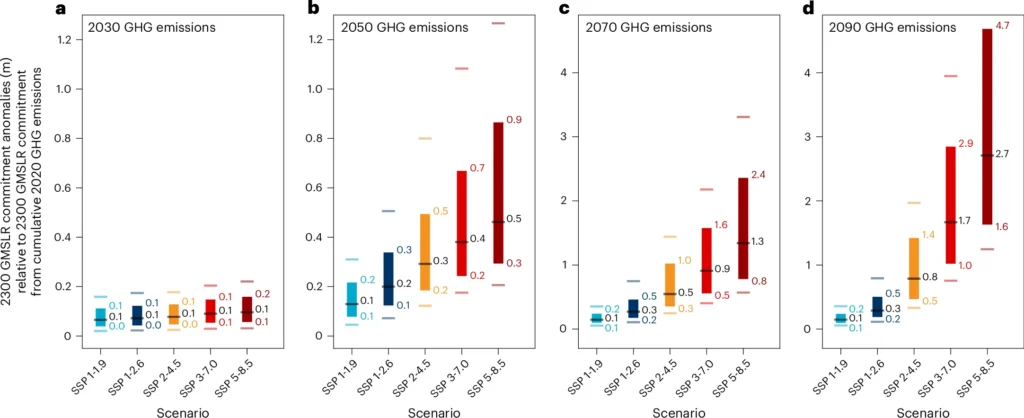
The authors find that, under the SSP2-4.5 “current climate policies” scenario, human-produced greenhouse gas emissions over 2020-50 will lock in an additional 29cm of sea level rise by the year 2300. This number grows to 79cm when including emissions out to 2090 under this scenario.
Meanwhile, under the scenario consistent with the 1.5C limit, only 15cm of additional sea level rise will be locked in by 2090.
This means that efforts to cut greenhouse gas emissions over the coming decades could curb long-term sea level rise by an extra 64cm.
The study authors say that their results “reinforce how every increment of additional peak warming from cumulative emissions irreversibly increases sea level rise”.
Dr Alexander Nauels is a science adviser at Climate Analytics and lead author on the study. He tells Carbon Brief that the world is “already committed to a really substantive amount of sea level rise” and stresses that this must be considered in terms of “adaptation, planning and risk management”.
However, he adds, “if we reduce emissions rapidly in the coming decades, there is a clear path to limiting the legacy of sea level rise that we would produce in the coming decades”.
Dr Catia Domingues, is a researcher at the UK’s National Oceanography Centre and was not involved in the study. She tells Carbon Brief that the study’s methodology is “clever and necessary”. She adds:
“[The study] clearly shows how the emissions from just the next 30 years, under current climate policies, will write an irreversible chapter for centuries to come, locking in significant sea level rise on their own.”
Warming levels
The authors also calculate the committed sea level rise at different warming levels.
The chart below plots sea level rise against warming level for every scenario and time period used in the study. It highlights how higher levels of warming commit the world to ever higher seas.
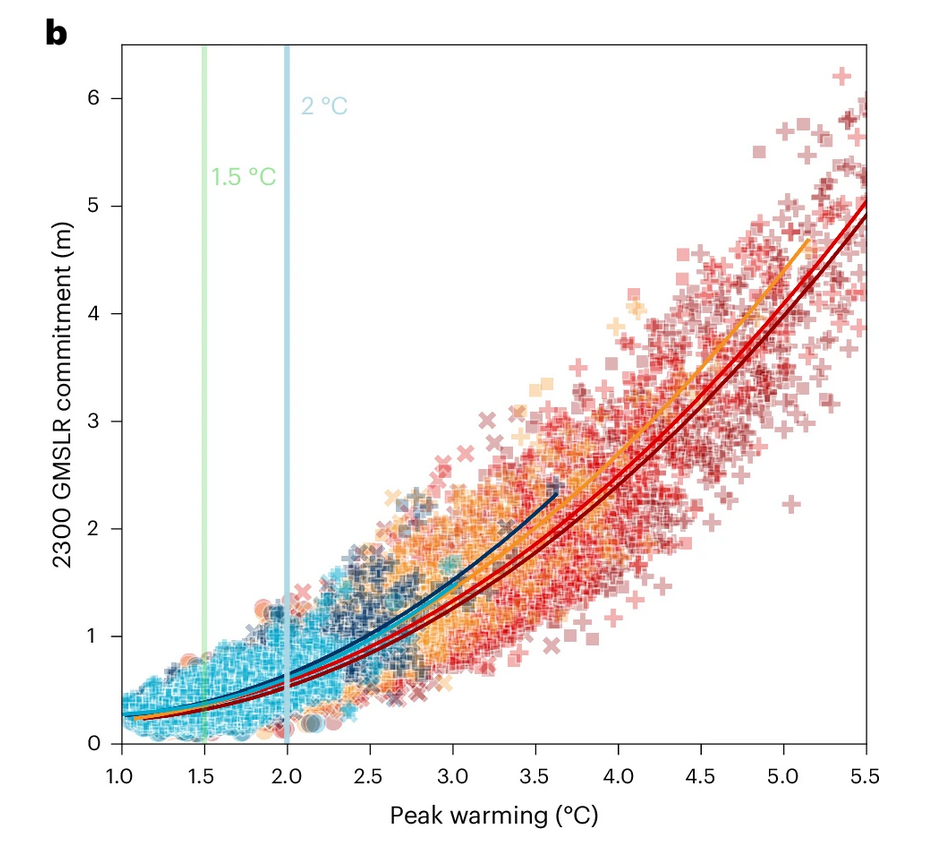
Committed sea level rise by 2300 at different warming levels, under SSP1-1.9 (light blue), SSP1-2.6 (dark blue), SSP2-4.5 (yellow), SSP3-7.0 (red) and SSP5-8.5 (dark red) pathways. Circles, X’s, squares and crosses indicate data points for 2030, 2050, 2070 and 2090 respectively. The green and blue lines show the 1.5C and 2C temperature thresholds. Source: Nauels et al (2025).
The authors note that the relationship between global temperature and committed sea level rise to 2300 is not “linear”, noting that the amount of sea level rise that is locked in by warming accelerates as global temperatures rise.
The authors explain that this is due to a “non-linear increase in ice mass loss in a warmer world” – in other words, physical feedbacks mean that higher levels of warming could see disproportionately large increases in ice losses.
Nauels tells Carbon Brief many sea level processes, such as ice-sheet responses, are still not “fully understood”. This means that when looking out to 2300, there can be “large uncertainties” in results, he adds.
Nevertheless, he argues that it is “still very important to explore the longer-term sea level response, because of the huge risk that is attached to it”.
Inequity
The main findings of the study focus on global average sea level rise. However, the authors note that sea level rise is not consistent across the world, with some regions facing faster rates of sea level rise than others.
This is largely due to ocean currents, driven by wind, warming, evaporation and rainfall, which push large masses of water around the planet. It is also caused by the bumpy, non-uniform surface of the earth.
To show these differences, the authors also selected a handful of coastal regions to study.
Nauels tells Carbon Brief that the study authors decided to focus on a handful of regions that “diverge” from the average global trend.
For example, they find that Pago Pago – the capital of American Samoa, which is made up of a string of coastal villages – will experience greater committed sea level rise than the global average.
On the other hand, Oslo is experiencing “land uplift” and actually shows a drop in sea level under the lowest warming scenario.
The NOC’s Domingues tells Carbon Brief that the study “exposes a deep inequity” between nations. She adds:
“This makes ambitious mitigation not just a climate necessity, but a climate-justice imperative.”
The post Rapid emissions cuts would avoid 64cm of ‘locked in’ sea level rise by 2300 appeared first on Carbon Brief.
Rapid emissions cuts would avoid 64cm of ‘locked in’ sea level rise by 2300
-
Climate Change2 years ago
Spanish-language misinformation on renewable energy spreads online, report shows
-
Climate Change2 months ago
Guest post: Why China is still building new coal – and when it might stop
-
Climate Change Videos2 years ago
The toxic gas flares fuelling Nigeria’s climate change – BBC News
-

 Greenhouse Gases1 year ago
Greenhouse Gases1 year ago嘉宾来稿:满足中国增长的用电需求 光伏加储能“比新建煤电更实惠”
-
Greenhouse Gases2 months ago
Guest post: Why China is still building new coal – and when it might stop
-

 Climate Change1 year ago
Climate Change1 year ago嘉宾来稿:满足中国增长的用电需求 光伏加储能“比新建煤电更实惠”
-

 Carbon Footprint2 years ago
Carbon Footprint2 years agoUS SEC’s Climate Disclosure Rules Spur Renewed Interest in Carbon Credits
-
Renewable Energy3 months ago
US Grid Strain, Possible Allete Sale

